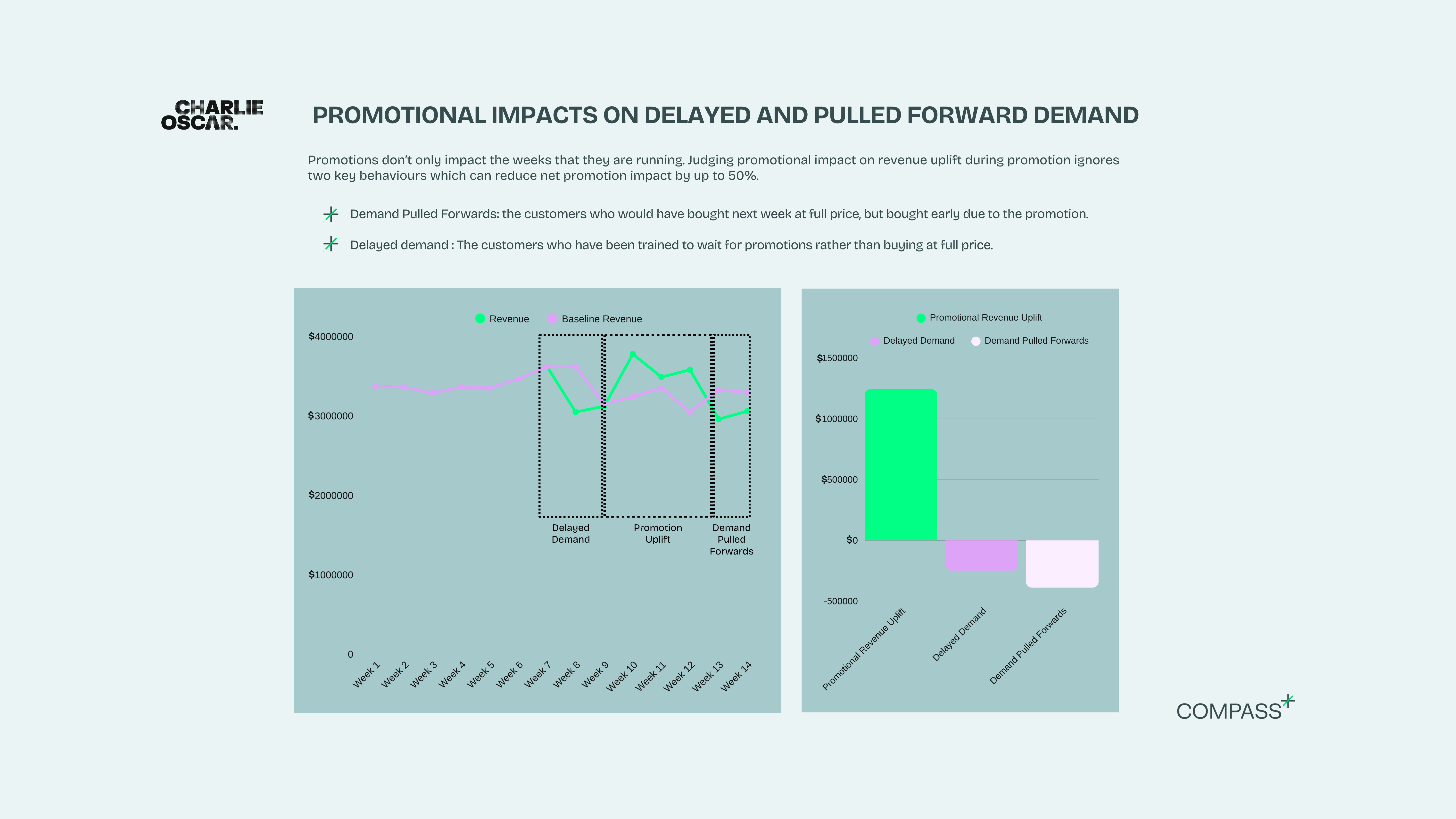
Why Understanding Promotional Effectiveness Feels Impossible
Understanding how effective your promotions and discounts are is tough.
𝗣𝗿𝗼𝗺𝗼𝘁𝗶𝗼𝗻𝘀 𝗱𝗼 𝗻𝗼𝘁 𝗮𝗰𝘁 𝗶𝗻 𝗶𝘀𝗼𝗹𝗮𝘁𝗶𝗼𝗻, and the success or failure of a promotion is highly dependent on what you do elsewhere.
When you run a promotion and sales go up by a larger ratio than the discount, then that might look like the promotion was successful. But it is 𝘁𝘆𝗽𝗶𝗰𝗮𝗹𝗹𝘆 𝗼𝗻𝗹𝘆 𝘄𝗲𝗲𝗸𝘀 𝗹𝗮𝘁𝗲𝗿 𝘁𝗵𝗮𝘁 𝘆𝗼𝘂 𝗰𝗮𝗻 𝗿𝗲𝗮𝗹𝗹𝘆 𝘀𝗲𝗲 𝗵𝗼𝘄 𝗲𝗳𝗳𝗲𝗰𝘁𝗶𝘃𝗲 𝘁𝗵𝗲 𝗽𝗿𝗼𝗺𝗼𝘁𝗶𝗼𝗻𝘀 𝗮𝗰𝘁𝘂𝗮𝗹𝗹𝘆 𝘄𝗲𝗿𝗲.
The Two Hidden Ways Promotions Trick You (and How to See It)
Promotions have two key impacts which are crucial to understand the real impact:
-
Promotions 𝗽𝘂𝗹𝗹 𝗱𝗲𝗺𝗮𝗻𝗱 𝗳𝗼𝗿𝘄𝗮𝗿𝗱𝘀 or pull demand from other sales channels.
-
Regular promotions start to train customers to 𝘄𝗮𝗶𝘁 𝗳𝗼𝗿 𝗱𝗶𝘀𝗰𝗼𝘂𝗻𝘁𝘀.
When you account for those impacts in measurement, we see that the true impact of promotions is 𝗹𝗲𝘀𝘀 𝘁𝗵𝗮𝗻 𝟱𝟬% 𝗼𝗳 𝘁𝗵𝗲 𝗶𝗻𝗰𝗿𝗲𝗮𝘀𝗲 𝗶𝗻 𝘀𝗮𝗹𝗲𝘀 𝗱𝘂𝗿𝗶𝗻𝗴 𝘁𝗵𝗲 𝗽𝗿𝗼𝗺𝗼𝘁𝗶𝗼𝗻𝗮𝗹 𝗽𝗲𝗿𝗶𝗼𝗱.
So while it looks like promotions have driven a significant impact, a large proportion of this is from demand which otherwise would have purchased in later weeks or through a different sales channel.
How We Establish the Real Baseline (and Why It Matters)
To understand the real impact of these promotions, you need to get a view of the baseline of “what would have happened if we didn’t run the promotion”.
This relies on being able to separate purchase behaviours from brand demand.
Promotions create a spike in 𝗽𝘂𝗿𝗰𝗵𝗮𝘀𝗲 𝗯𝗲𝗵𝗮𝘃𝗶𝗼𝘂𝗿𝘀 𝗯𝘂𝘁 𝗿𝗮𝗿𝗲𝗹𝘆 𝗰𝗿𝗲𝗮𝘁𝗲 𝗮 𝘀𝘂𝘀𝘁𝗮𝗶𝗻𝗲𝗱 𝘂𝗽𝗹𝗶𝗳𝘁 𝗶𝗻 𝗯𝗿𝗮𝗻𝗱 𝗱𝗲𝗺𝗮𝗻𝗱.
This is why we see the demand pulled forward and delayed purchase behaviours.
Why Promotions Mess with Marketing Measurement (and What to Do About It)
These impacts also have a drastic impact on how you assess marketing performance.
Campaigns run while customers are waiting for discounts appear to perform badly despite being crucial to generate the underlying demand that promotions later activate, while campaigns pushing promotions appear strong until you remove the pull forward promotional impact.
3 Surprising Findings from Our Modelling
Some common findings from our modelling outputs below:
• Increased Amazon sales driven on promotions (eg prime day) are around 𝟰𝟬%-𝟳𝟬% 𝗽𝘂𝗹𝗹𝗲𝗱 𝗳𝗼𝗿𝘄𝗮𝗿𝗱𝘀 from future Amazon demand or other sales channels (eg DTC or Retail.)
• 𝗕𝗹𝗮𝗰𝗸 𝗙𝗿𝗶𝗱𝗮𝘆 𝘀𝗮𝗹𝗲𝘀 𝘀𝗵𝗼𝘄 𝗯𝗼𝘁𝗵 𝗽𝘂𝗹𝗹 𝗳𝗼𝗿𝘄𝗮𝗿𝗱𝘀 𝗮𝗻𝗱 𝗽𝘂𝘀𝗵 𝗯𝗮𝗰𝗸𝘄𝗮𝗿𝗱𝘀 𝗱𝗲𝗺𝗮𝗻𝗱 𝗲𝗳𝗳𝗲𝗰𝘁𝘀 with customers waiting for promotions they have been trained into expecting.
These effects have been long established in US, and are increasing YoY in UK and Europe.
• 𝗟𝗶𝗺𝗶𝘁𝗲𝗱 𝗿𝗲𝗮𝗰𝗵 𝗽𝗿𝗼𝗺𝗼𝘁𝗶𝗼𝗻𝘀 (limited by either audience, product range or duration) show lower demand pull forward impacts and typically stronger incremental revenue and margin impact.
The Bottom Line
Without accounting for these impacts, promotions can look very successful on a weekly revenue graph but actually net out to be detrimental to longer term business growth.

